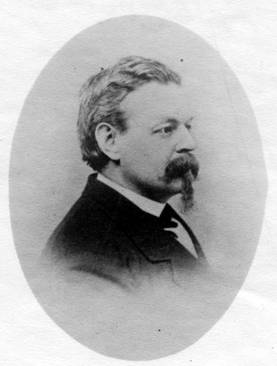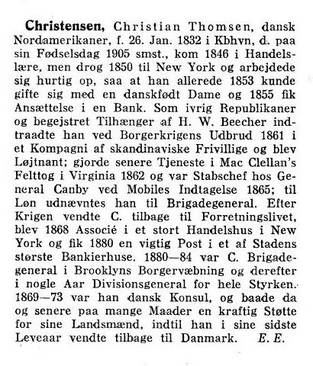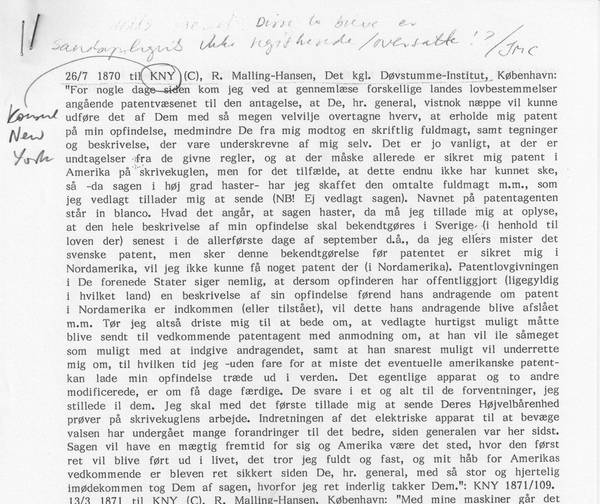1870.07.26 English
SA: This is a very interesting letter, and only rather late in the process of transcribing all of the known RMH-letters electronically this letter has come to our attention. So far, we know of only a transcribed version, coming from the archive of the Danish Consulate in New York. We have two letters from this archive, and they have both been marked KNY 1871/109. Both letters were originally handwritten and contain some very interesting information about the very first writing balls ever made. They were addressed to general Christensen in New York, and it has been rather complicated to find out who this person really was, because RMH also corresponded with a Christensen in Copenhagen. For quite some time we were under the impression that it was one and the same, but recent investigations have shown that this letter was for the Danish-American Christian Thomsen Christensen who also took part in the American civil war and was promoted to the rank of general. For three years, from 1870 until 1873, he was consul of the Danish Consulate of New York and during periods he was also a businessman. He was known as a valuable supporter of Danes in America. The transcriber has modernized the writing somewhat, among other things he has not used the capital letter in nouns (otherwise used at the time in Danish), also using the vowel ‘å’ instead of ‘aa’ (in the Danish version), and we are here reproducing the letter in its modernized form.
26/7 1870
R. Malling-Hansen.
The Royal Institute
of the Deaf-Mute,
Copenhagen.
Some days ago, by studying the patent laws of various countries I came to the conclusion that you, General Christensen, will hardly be able to carry out the task that you have so graciously accepted, namely to achieve a patent on my invention, unless you receive from my hand a power of attorney in addition to drawings and descriptions, signed by me. Exceptions to the rules of course occur frequently, and perchance there is already an American patent secured for me on the writing ball, but in the event that this has not yet been possible, then – and since the issue is indeed urgent – I have arranged the power of attorney etc, that I allow myself to forward to you (NB! No enclosed). The name of the patent agent is in blank. On the issue of haste, allow me to inform you that the complete description of my invention is to be published in Sweden (according to rules and regulations in that country) in the beginning of September this year, at the very latest, since I risk otherwise to lose my Swedish patent, but if this announcement is made before I have the patent secured in North America, I will not be able to get any patent there (in North America).[1] Because the patent regulations in the USA states that if the inventor has published (irrespective of which country) a description of his invention before his application for a patent in North America has been received (or granted), this application will be denied etc. Therefore, may I venture to request you to make sure that the enclosed documents will be sent as soon as possible to the relevant patent agent together with a request that he may make haste as much as possible to present the application, and that he will inform me – as soon as possible – at what point in time I – without danger of losing the pending American patent – can allow my invention to be presented to the world. The machine, as well as two other modified versions, will be ready in a few days. [2] They respond in each and every way to my expectations. Presently, I shall permit myself to send your Grace samples of the writing ball writing. The arrangement of the electrical device to move the platen has undergone many changes since you were here last time, Sir. [3]This cause will have a tremendous future, and America will be the place where it will be primarily and properly accomplished, this is my firm belief, and my hopes for America have been even more secured since you, Sir, took on the cause so courteously and obligingly, and for which I wish to thank you with all my heart. [4]
[1] SA: It is somewhat surprising to read that RMH intends to detain the application for a Swedish patent on the grounds that the patent description of the invention is not allowed to have been made public in other countries prior to the patent application in America, considering that already at this time he possessed patents in three countries, namely – as far as we know – in Denmark, England and Germany.
JMC: My guess is that RMH was only made aware of these regulations rather late in the process; and when he realized the legal implications, he probably made the assessment that the patent in America was far more important than the one pending in Sweden – or any other patent pending on European soil.
[2] SA: This letter was written almost two months before the writing ball was presented for the first time to Danish journalists, and it is very interesting to read that the very first writing ball was finalized around this time. It is also worth noting that there were already certain changes being made in two other models under construction. We must conclude that as many as three writing balls had been finalized when the writing ball was presented to the public, on September 8, 1870.
[3] SA: if we can find out exactly when General Christensen visited Denmark, this will also enable us to establish with more accuracy when work on the first writing ball started.
[4] SA: It is almost touching to read about the optimism RMH felt at this point in time in relation to the future of the writing ball. Unfortunately the actual events did not bear out his optimism. In 1868 three Americans acquired the patent of an American writing ball (Sholes, Glidden and Soule), and the investor James Densmore subsequently bought their patent, developed the machine further and had it produced at the Remington factories in 1873. At that time this machine was not superior to the writing ball, and as late as 1878 at the world exhibition in Paris the writing ball was assessed by the jury to be far superior in many aspects. (The writing ball was awarded a gold medal, and the “typewriter” got the silver medal). However, during the 1880s the writing ball was slowly but surely ousted from the market, possible because RMH during this period gave more priority to his scientific research and did not promote the writing ball in the same way he managed to do in the beginning of the period. And when RMH suddenly passed away in 1890, his departure did away with the hope that the writing ball would ever be able to compete in the global market.



